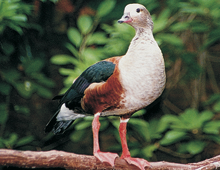Description: Both sexes of the Orinoco goose are similar in appearance. The head, neck and breast are a pale grayish-buff with darker mottling and striations along the rear and sides of the neck. The flanks and belly are chestnut; the upper mantle and scapulars are rufous; the bill is black with a hint of pink; the back, rump and tail are greenish-black; the wings are purplish-to greenish-black with a white patch at the base, and the legs are red.
Size: Adults grow to 24-30 inches (61-76 cm) in length with males generally weighing more than females; around 3.4 pounds (1.54 kg) for males and 2.7 pounds (1.22 kg) for females.
Behavior: This species is mainly terrestrial, but during the breeding season they will perch in trees. During their noisy, territorial defense displays, they assume such an upright position that it looks as if they might fall over backwards. Males will display by pulling back their head, expand their chest, flap their wings and charge toward any pending threat. They form bonding pairs that stay together year round.
Diet: They feed primarily by grazing on the savannah lands adjacent to the rivers by which they nest. They will also eat aquatic plants, herbs and insects.
Communication: Males communicate using a high pitched whistling call and females a loud cackling call.
Reproduction: During breeding time, the pair will roost in a tree cavity that has been lined with down. The female will lay 6-15 pale brownish-cream eggs that are incubated for about 30 days. The male stays close to the nest during this time.
Habitat/range: They are endemic to South America and found along the Orinoco and Amazon basins from eastern Colombia and Venezuela, to eastern Bolivia and central Brazil; and in western Paraguay and northen Argentina. They inhabit forest covered banks, wet savannas, muddy and sandy shores of freshwater wetlands.
Status: They are listed as Near Threatened on the IUCN Red List.



